Abstract
In the coastal zones, varied uses converge, some of them of priority interest. In this study, an integrated method for the planning and management of the territory is proposed, which includes the evaluation of sustainability. A total of 15 different land-use classes were estimated in 80 sampling units distributed regularly along the Pacific coastline of Nicaragua and classified to determine land management sectors. For each of the identified sectors, the ecological, economic, social, and productive dimensions were evaluated independently, handling a total of 53 variables from different databases, by means of ordination multivariate factor analysis. Subsequently, the four dimensions were integrated into a model and the results were evaluated based on their similarity with theoretical development scenarios, assessed by discriminant analysis. Among these, the scenarios considered as a goal for sustainability in the studied area were present. On the Pacific coast of Nicaragua, productive and economic activities are currently prioritized, without having an integrated planning scheme for the entire territory, which includes nature conservation. The main contribution has been to provide a method for evaluating the land in an integrative and multidimensional way, while at the same time qualifying the different territorial sectors from a sustainable development. Even under a context of relative scarcity of information for some relevant aspects, the dimension-values assessment is largely solved by ordering the territorial sectors with a multivariate strategy, so that they are classified in relative and not absolute terms, which allows the strategy to be very useful for countries lacking some databases and cartography. This holistic and comprehensive vision of the entire territory facilitates social participation and contributes to decision-making aimed at advancing toward sustainability.
1. Introduction
Coastal zones can be defined as the areas where natural terrestrial and marine processes overlap and interact. They constitute unique areas of high biodiversity where varied uses converge, some of them essential for human activity, such as commerce, tourism, industry (refinery, ports), residential areas, and communities dependent on fishery. They also provide aesthetic values and areas for sports and recreation, and play a significant role in our cultural heritage. Yet, while activities such as fishery and tourism are beneficial to the economy and human well-being, they can also modify the natural stability of these areas, and place significant pressures, including loss of and damage to biodiversity, contamination, and introduction of nonindigenous species [1,2,3]. The confluence of such different uses makes coastal areas highly sensitive to the environment and triggers a conflict over how space is occupied [4,5]. With a constantly growing strategic value from different perspectives—physical–natural, economic–productive and legal–coadministrative [6]—a mounting stress on such valuable ecosystems stands out. Given the recognized importance of coastal resources and the ecosystem services they provide to humans, sustainable management of their natural resources becomes essential and constitutes a growing body of scientific literature. However, the subsequent spatial planning policies, which should be harmoniously combined with the needs arising from the management of their natural resources, remain complex and far behind.
Land planning and management to approach such an overall view are also complex. Reasons are due to the interplay of ecosystems of different nature, the necessary coherence between the broad (national or regional) and the local planning scales, and the need of an integrated approach that reconciles all demands avoiding conflicts [7,8,9]. Therefore, understanding the interaction between expectations of use in a given territory, while recognizing its multifunctional nature, is key to successful planning of humanized landscapes and the values generated by their own idiosyncrasies [10,11,12], and policies must be effective in addressing these challenges [13].
As it has recently been highlighted, there is a gap in contemporary land-planning theory with regard to the survey methodology of land uses, and rethinking the methodologies for planning and management is needed [14,15]. Reviews of the evolution of urban land-use survey methodologies during the last century reveal that methodologies have been seriously trivialized, with simplistic and empirical approaches to land-use survey methodology [16]. However, in the context of multicriteria decision analysis, numerous methods are applicable in different decision-making situations, although advice for selecting the most appropriate for the specific field of application and problem has not been thoroughly investigated [16].
Land-use planning has been the usual tool for an efficient management of spatially distributed resources, including the adaptation of land-use paradigms to changing environmental or socioeconomic circumstances [17]. However, for confronting the new challenges imposed by global change, improved tools able to plan sustainability are needed, and should include the sustainable development goals established by the United Nations [18,19]. Territorial management must ultimately facilitate adoption of measures capable of anticipating new territorial conflicts and trade-offs, including those derived from global change. Moreover, they have to be available to decision-makers, in order for them to propose responsible policies on sustainability. Furthermore, this is especially important in developing countries, as in the case of the region considered here.
In countries with greater access to information, cartographic sources, well-established planning tools, and complex methodologies have been used for land management and evaluation [20,21,22,23,24], but until now they have not evaluated the sustainability of the current and future possible actions. This is worrying, as the United Nations has recognized the 21st century as the century of sustainability. Therefore, now is the time in which it is essential to face the main social and environmental challenges arising from global change.
The aim of this study is to propose a methodology that points directly to contexts in which available territorial information to start with is limited, and there is a need for research and resource analysis. This is the case of the coastal areas in many developing countries, where complexity is high and available data are often scarce. Social and institutional stakeholders could use this information to design programs and public policies, and to evaluate their effects on the territory’s capacity to provide different ecosystem services [5,11]. Moreover, our objective is to integrate territorial analysis with evaluation of sustainability, thus adding to a resulting territorial planning the possibility to evaluate how the adopted decisions fit with previous established sustainability goals. We also consider handling different scenarios of sustainability in the analysis, thus opening a final discussion on the different degrees of model fitting obtained.
To achieve these goals, we go through a two-step process. In the first phase, we establish Land-Management Sectors based on the varied types of land use, to carefully identify possible conflicts among uses. In the second phase, we evaluate the Sustainability status corresponding to the different sectors, considering the ecological, economic, social, and productive dimensions of sustainability, and contrast them with the previously constructed theoretical development scenarios, which include the scenarios that could be considered as a target for most of the studied sectors.
2. Materials and Methods
The study area corresponds to the coastal line of the Pacific of Nicaragua (450 km), administratively divided into five departments and 12 municipalities. It is part of the Pacific Coastal Plain, delimited by the Los Maribios volcanic mountain range (Figure 1).
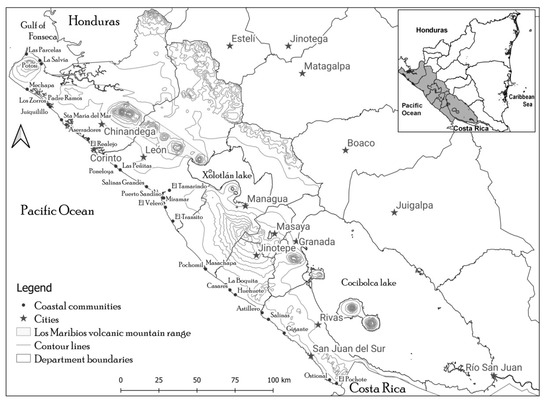
Figure 1.
Relief and administrative distribution of western Nicaragua, with indication of cities and communities (i.e., small human settlements that share similar uses like fishing or tourism activities).
The dominant climate is subtropical, with “Subtropical Humid and Hot Forest” in the Chinandega and León provinces, “Subtropical Dry and Hot” at the north and south of Lake Xolotlán, and “Tropical Dry Forest” on the southern coast [25,26]. Six protected natural areas from the Habitat/Species Management categories of the International Union for Conservation of Nature (IUCN) are present in the area: four Nature Reserves and two Wildlife Refuges [27].
2.1. Identification of Land-Management Sectors
We established 80 sampling units (SUs) regularly distributed every 5 km along the coast, generated from the sea–land boundary. The SUs had a circular area of 2.5 km radius (1.963 ha), a surface that allows the detection of the different land uses at a detailed scale.
Based on aerial orthophotos, we defined 15 types of land use: Beach, Wetland, Estuary, Aquaculture, Mangrove Forest, Saltworks, Artificial Lagoons, Dry Tropical Forest, Gallery Forest, Scrub, Forest Plantations, Agriculture, Livestock, Roads, and Infrastructures [26]. Land uses were expressed as percentage of the SU area covered. Orthophotos from 2013 were corrected by the Nicaraguan Institute of Territorial Studies (INETER), with the support of Google Earth Images (free version). The size of each pixel was 1 m, and the digitization scale of the polygons was 1:1000. The percentage of sea occupation at every SU was also noted.
Combinations of land uses among the coastal sampling unites were detected, which were explored by principal component analysis (PCA) [28] to interpret those main combinations found. We also performed a hierarchical classification analysis (Ward’s statistic) to obtain homogeneous linear segments (consolidated coastal sections formed by SUs belonging to the same class) that we identified as components of the Land Management Sectors (LMSs)—each of the classes identified in the cluster analyses, connected by transition zones (sections formed by SUs of different classes). The statistical analyses were performed with the SPSS software and Community Analysis Package (version 3.1) for the multivariate classification and PCA, and ArcGis 10 software was used for the territorial analyses.
2.2. Multidimensional Analyses for the Evaluation of Sustainability
The sustainability analysis applied the model proposed by Gómez-Sal et al. [29]. This methodology is based on identification of relevant dimensions to assess sustainability of the land uses, and posterior comparison to reference development scenarios [10,29]. For this study, four relevant development dimensions were considered: Ecological, Economical, Productive, and Social, which were assessed through the data from 53 variables (Table 1).

Table 1.
Dimensions selected to assess the sustainability of development, with indication of aims and set of variables chosen for the multivariate evaluation of each.
An important amount of the social, economic, and productive data was obtained through surveys directed to the leaders of 30 communities located on the Pacific coastline of Nicaragua. Surveys were carried out from October to December 2013. Other relevant information came from the National Fisheries survey [30], which includes data on vessels, total catches, and number of fishermen, among others. The information for the maritime ports came from the official Report of the Nicaraguan State for 2013 [31]. Finally, the data on the ecological variables were obtained from the analysis of land uses in each of the 80 sampling units. A matrix was elaborated with this set of variables according to their role for the evaluation of the four dimensions considered, where a variable may be involved in the evaluation of more than one dimension.
The continuous variables were transformed into discrete variables (0 = absent, 1 = present), developing a matrix of numerical data for each dimension in which the LMS and the set of 53 variables selected were listed. The LMSs were ordered for each dimension using detrended correspondence analysis (DCA) [32].
The data of the new variables (the coordinates of the different LMSs in the first axis of the DCA) for each of the analyzed dimensions of development were subject to a reassignment of values to facilitate their integration into the models that represent different development scenarios [29]. The new values varied between 0 and 100, so that the lowest coordinate value (including negative values) corresponded to 0, and the highest to 100. In this way, a gradient was established from low to high values in the ordination of LMSs for each of the evaluative dimensions. The results of the reallocation allowed a comparable approach (between 0 and 100) for the different dimensions. To support the consistency of the model, the independent nature of the dimensions considered was analyzed by means of a correlation between the first axes of the respective DCA. A summary scheme of the procedure can be seen in Figure 2.
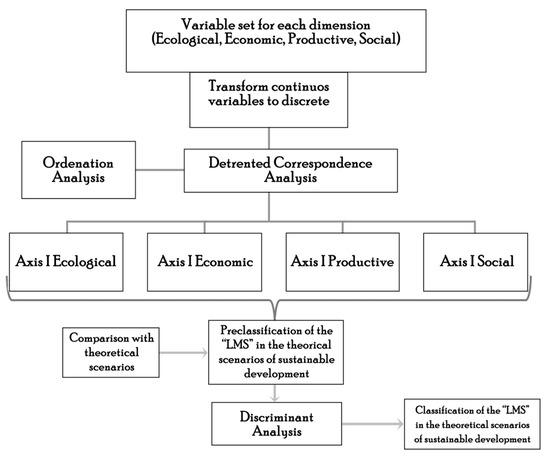
Figure 2.
Stages of multidimensional analysis applied to the evaluation of development and the comparison with theoretical scenarios of sustainable development.
2.3. Integration of the Dimensions and Comparison with Theoretical Scenarios of Ssustainable Development
In addition to the independent estimation of each dimension of the respective sections of the coastline, the objective was to obtain an integrative evaluation of the four dimensions on each section and the LMS of which each was a part. This integrated evaluation was compared to the theoretical scenarios previously established [29,33] (Table 2, Figure 3). The assignment of the sections to one or another scenario was carried out through discriminant analysis.

Table 2.
Theoretical scenarios considered to estimate the degree of similarity with the models obtained at the sectors of study, and their descriptions. Based on the scenarios proposed by Gómez-Sal [29,35] and Gómez-Sal and González García [10], expanded with a new scenario (Close conservation).
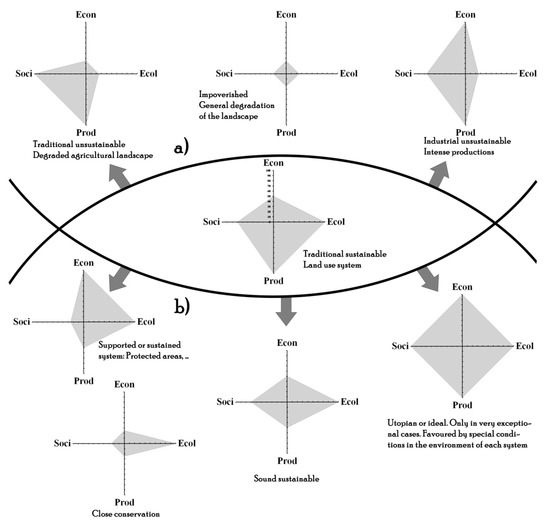
Figure 3.
Dynamic diagram of the relationships among the theoretical scenarios considered for the evaluation, by comparison with the results obtained for each coastal section. From a traditional sustainable scenario: (a) scenarios towards degradation of landscapes and natural values; (b) scenarios towards conservation of nature and environmental services. Modified from Gómez-Sal et al. [29], with the addition of the social dimension and adapted to the development context of the present research.
The statistical analyses were carried out with the statistical program PAST v3.12 [34] (free version).
3. Results
3.1. Land-Use Spatial Patterns
The Pacific coastal zone of Nicaragua presents a high diversity of land uses covering both terrestrial and marine-transition ecosystems. Tropical Dry Forest is present throughout the entire coastal zone (29.3% coverage in the entire area), with the highest coverage in the southern sector (with more than 40.4% for each sampling unit) (Figure 4(Aa)) and important extensions in the north (the Cosigüina Volcano protected area). Gallery Forest represents 2% of the total sampled area and is mainly distributed in the south (Figure 4(Ab)). The Scrub land-use class covers 3.3% of the total area and is located in the central part of the coastline (Figure 4(Ac)). The largest Infrastructures area is located in the South and is tourist-oriented (the municipality of San Juan del Sur; Figure 4(Ad)); therefore, it appears linked to the highest density of roads in this area. The Infrastructures in the coastal zone are mainly associated with urbanized areas. The highest coverage of housing and industry is located in the southern zone due to the touristic activity. On the other hand, in the north there is a restriction of infrastructures due to the greater presence of protected areas, mangroves, and the scarcity of road accesses. The communities that occupy more than 10 ha of the coastal zone correspond to cities with more than 1000 inhabitants. San Juan del Sur and Corinto, the country’s main port, represent the highest population densities on the coast, with more than 15,000 inhabitants.
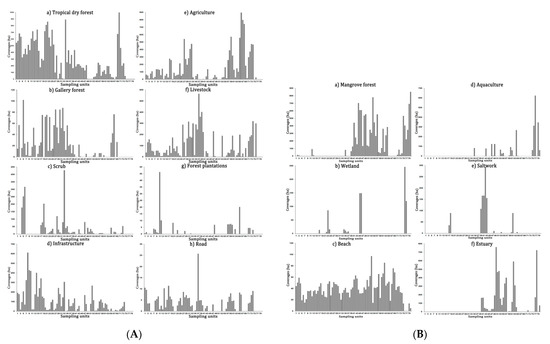
Figure 4.
Distribution and relative coverage of the land-use types identified on the Pacific coast of Nicaragua: (A) Terrestrial zone land uses; (B) Marine-transition zone land uses. Numbering of the sampling units is from south to north of the Pacific coastline.
Agriculture is the second category with the highest coverage. It is distributed in a higher percentage in the center and north (Figure 4(Ae)). The areas dedicated to Livestock farming are located along the entire coast, but the greatest coverage is found in the central zone (Figure 4(Af)). Productive activities include wood and energy, mainly in the south and north (Figure 4(Ag)). In 80% of the sampling units, roads were present (Figure 4(Ah)).
Regarding the transition environments (zone of influence of the sea), Mangrove Forest is distributed in the north (Figure 4(Ba)), as well as in the Estero Real (a relevant wetland basin) and surrounding areas. Wetlands were identified in seven sampling units (1.0%; Figure 4(Bb)). Beaches are distributed in 96% of the coastline, being generally longer in the north (Figure 4(Bc)). Aquaculture, with shrimp production (Litopennaeus vannamei and L. stylirostri) is linked to the presence of mangroves, so the coverage related to this activity predominates in the northern zone, located between the municipalities of León and El Viejo (Figure 4(Bd)). Aquaculture areas that are also present in the central part of the coast are linked to breeding areas for broodstock and larval production.
For salt production, 90% takes place in the central part of the studied area (Figure 4(Be)). Estuaries have a similar distribution to the mangrove swamps (Figure 4(Bf)).
The land-use analysis allowed the identification of similar territorial combinations of land uses, which were explored by PCA (Table 3). The first component of the PCA was strongly influenced by the presence of the Mangrove ecosystem and Aquaculture activities, categories that depend on the presence of estuaries. In the second component, the categories associated with environments with a greater presence of the sea (Beach and Estuaries) predominated, accompanied by productive activities such as Aquaculture and Livestock. Finally, the third component was dominated by the Tropical Dry Forest (natural systems little intervened) compared to productive activities.

Table 3.
Main combinations of land-use classes derived from PCA (matrix on land uses x sampling units). The minimum and maximum loads of the land-use variables, and the interpretation of the axes, are indicated.
From the hierarchical classification analysis, we obtained two large groups of units related to terrestrial and marine/transitional environments (Figure 5). The main dividing variable was the presence or absence of Mangroves.

Figure 5.
Classification of the 80 sampling units (SUs) into eight land-use units contained in two main groups: (A) Includes SUs related to the marine–coastal environment; (B) includes SUs located in terrestrial environments.
Of the 80 sample units analyzed, 54 corresponded to the terrestrial environments group, while 26 corresponded to the marine–coastal environments group. For each of the two large groups, another level of classification identified eight more detailed groups, whose main features are detailed in Table 4.

Table 4.
Description of the groups of land-use units. The names reflect the dominant land-use coverage. Total number of sampling units represented is also indicated.
The spatial distribution of the land use units along the coast is shown in Figure 6. For each of the groups, its canonical unit was identified as the one showing most similar values to the average of the group (Figure 6).
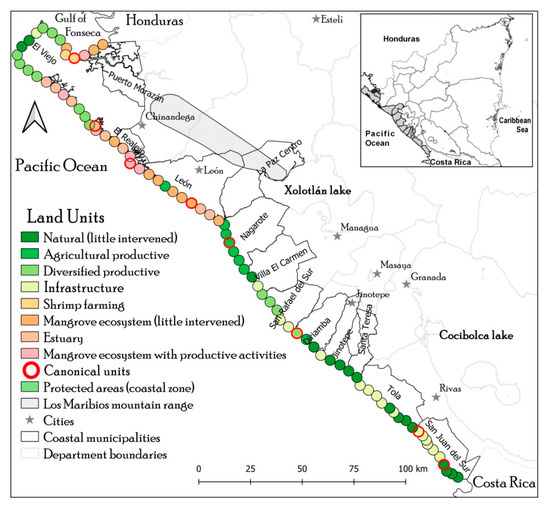
Figure 6.
Distribution of the different land-use units along the Pacific coastline of Nicaragua, with indication of their canonical units.
3.2. Land-Management Sectors
The transference of the different land-use units to the territory allowed the identification of 21 homogeneous sections that contained land units of the same group. The length of these sections varied between 10 and 25 km, and they could include two or more land units. They were not always contiguous; in those cases, they were connected by heterogeneous zones considered transitional (Figure 7).
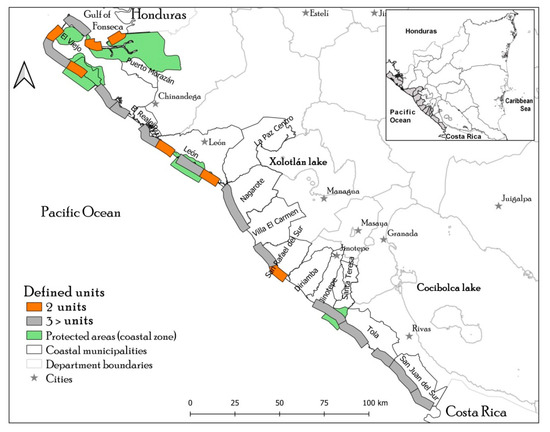
Figure 7.
Distribution of coastal sections in which the land units belong to the same class. The voids between them correspond to heterogeneous zones.
In order to obtain homogeneous land sectors covering the whole coastline, the land units from those transitional zones were assigned to one of the contiguous sections, according to their similarity, based on the results of the ordination analysis (PCA) (Table 3) performed as a complement to the classification for practical management. Finally, 8 sectors covered the coast, each of them dominated by one type of the land-use units. This proposal of Land-Management Sectors (LMS) (Figure 8) made it possible to simplify the complexity of the territory, creating relatively homogeneous spaces that facilitated its understanding as well as the analysis and management of the processes that converge in it, endowing the territory with different functions and meaning.
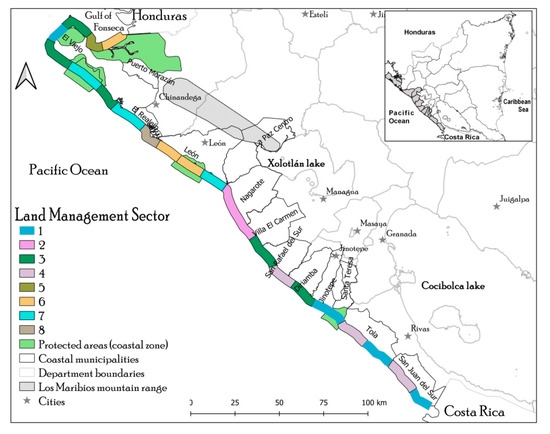
Figure 8.
Spatial distribution of the eight Land-Management Sectors along the coast, and indication of the main land use units represented in them: 1. Natural (little intervened); 2. Agricultural productive; 3. Diversified productive; 4. Infrastructures; 5. Shrimp farming; 6. Mangrove ecosystems (little intervened); 7. Estuary; 8. Mangrove ecosystem with productive activities.
3.3. Multicriteria Evaluation of the Land-Management Sectors
From the results for each of the evaluative dimensions, we were able to obtain different readings for the sustainability for each LMS, taking as a reference the coordinates of the 21 sections in the respective first axes of the DCAs (Figure 9). With this information, it was possible to appreciate the different importance of the processes (ecological, productive, social, and economic) considered of interest for evaluating the development sustainability in the different sectors of the coastal strip.
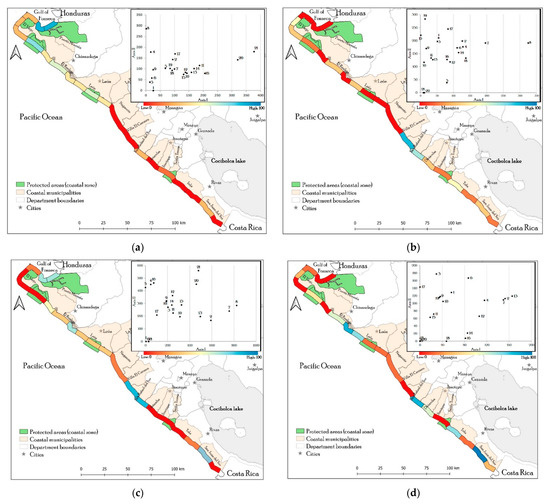
Figure 9.
Distribution of the 21 sections of the coastline ordered according to the value obtained in the first axis of the respective DCA analysis. Dimensions: (a) Ecological; (b) Productive; (c) Economic; and (d) Social. Blue and red represent the highest and lowest values, respectively. The scale was made equivalent to 0 to 100.
The highest values (blue) of the ecological dimension were presented in the north, and the lowest (red) toward the center and south of the coastline. The productive dimension showed varied high average values toward the southern half of the coast, while the highest values of the economic dimension were located in the central zone and in the extreme south. Finally, the high values of the social dimension appeared disjointed in different areas of the coastline.
3.4. Theoretical Scenarios of Sustainable Development
Correlations between the first axes of the evaluative dimensions were carried out to analyze their possible redundancy. Table 5 shows a low correlation between the dimensions, indicating that they could be interpreted as independent and represented as Cartesian axes of a hypothetical factorial space.

Table 5.
Pearson correlations between the evaluative dimensions of sustainable development.
The result of the discriminant analysis assigned the 21 coastal sections to five of the eight theoretical scenarios of sustainability (Table 6). Of the analyzed sections, 50% corresponded to scenarios that reflected degradation of ecosystems and loss of natural value. Likewise, the predominance of the sections corresponding to the “traditional sustainable” and “traditional unsustainable” scenarios was observed, with the latter mainly associated with intensive agriculture. The theoretical scenarios “impoverished”, “utopian”, and “close conservation” were not represented.

Table 6.
Discriminant analysis classification of the 21 coastline sections in relation to the eight theoretical scenarios of sustainable development.
The largest proportion of the coastline was classified into the traditional unsustainable scenario, in which the excesses of the production system caused the degradation of the ecosystems, compromising future well-being of local communities. In general, these were sections characterized by the intensive production of sugar cane and peanuts.
The spatial pattern distribution of the five identified development scenarios on the Pacific coastal zone of Nicaragua was heterogeneous (Figure 10).
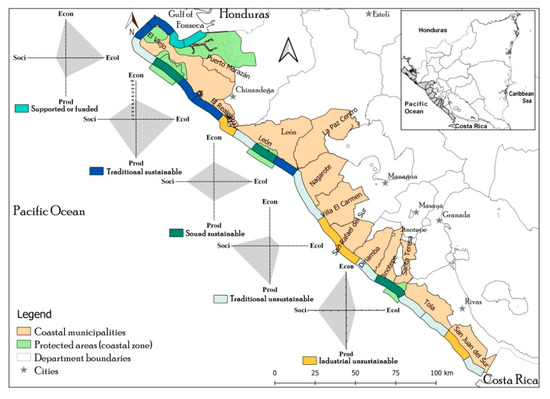
Figure 10.
Results of applying the sustainability assessment model to the 21 coastal sections. The five theoretical scenarios to which the discriminant analysis assigned each of the sections are represented.
The largest number of sections was related to unsustainable traditional and industrial scenarios in the south, as well as to the sustainable traditional and sound scenarios in the north. The industrial unsustainability scenario was located in San Juan del Sur, Villa El Carmen, San Rafael del Sur, and Corinto.
The scenarios characterized by nature conservation and environmental services appear divided between the supported or funded and sound sustainable scenarios, with three sections each. Five of the sections corresponded to protected areas, classified as Natural Reserve and Wildlife Refuge. The only protected area that was classified into the traditional sustainable scenario was the Chacocente Wildlife Refuge (Santa Teresa).
Attending to the distribution of scenarios per municipalities, the coastal zone of El Viejo was revealed as highly complex in terms of land management due to the presence of four different scenarios (Table 7). León and San Juan del Sur contained three scenarios, each of them with a section in the sound sustainable scenario. The rest of the municipalities were made up of one or two scenarios for their coastal lines.

Table 7.
Distribution of the theoretical sustainability scenarios for each of the coastal municipalities of the Pacific coast of Nicaragua.
4. Discussion
4.1. General Land-Use Analysis
The Mangrove and Tropical Dry Forest were the natural ecosystems predominating in the coastal strip studied. These ecosystems are under constant pressure due to the increase in productive activities such as aquaculture, livestock, agriculture, and infrastructures [36,37,38,39], so their ecological integrity and capacity to provide ecosystem services is threatened. Even so, those landscapes managed through traditional productive activities (diversification and local ecological knowledge) maintain valuable characteristics for the formulation of more sustainable development models [29]. The main impacts leading to mangrove loss are associated with the expansion of shrimp farms, deforestation (for firewood), advancing of the agricultural frontier, urbanization, sedimentation, and water pollution [40]. The most fragile ecosystems are threatened by social and economic pressures from both the coastal zone itself, and from adjacent areas [41]. Infrastructure plays an important role in urbanized landscapes. The largest coverage of land in homes, industries, and roads is located in the southern zone due to the increase in tourist activity. On the other hand, in the north, this expansion is more limited, due to the creation of protected areas, the presence of the mangrove forest, and the scarcity of road infrastructure, also due to less accessibility from the most populated areas of the country.
4.2. Land-Management Sectors
The analysis based on a regular sampling of land use units was demonstrated to be effective in identifying land-management sectors, some of them with a multifunctional nature and others with different degrees of specialization [10]. These LMSs can also be analyzed according to their ability to provide different ecosystem services [12].
This result is an important contribution to understanding the territory, since it characterizes different sections and LMSs from a multicriteria perspective. In previous works referring to the classification and planning of the Pacific coastal zones of Nicaragua, only ecological and conservation aspects were considered, forgetting their interaction with other uses that can be relevant as social and economic drivers of change [41,42]. The identified land-management sectors allow characterizing land complexity through sections that facilitate management of the processes that overlap in the territory, and endow it with different functions and meaning. The proposal of LMS can serve as a tool for management [43], with a perspective of natural resources conservation and sustainability building. These classification-based analyses offer a disciplinary ‘‘neutral’’ tool, which can be used to improve communication of data and concepts, social participation, and active collaboration between multiple disciplines [44].
The characterization of coastal land by means of the regularly distributed sampling units provided detailed and accurate information, allowing management of natural and anthropic variables together [23]. Coastal areas in developing countries, with outstanding natural values, are characterized by high complexity [6,8,45] and often poor data. For this reason, we considered that the approach adopted in this work was suitable for organization, research, and analysis of data in similar contexts [44]. Heterogeneous landscapes require the formulation of comprehensive policies aimed at strengthening sustainable management with well-established goals in systems that are multifunctional [11].
The coastal zone classification through LMSs can help decision-makers to define management plans with the active participation of key stakeholders, taking into account local knowledge and the prosperity aspirations of communities. In similar coastal environments, there are experiences in which actions carried out at the local level have contributed to progress in integrated management [46,47,48].
4.3. Comprehensive Evaluation of Sustainable Development
Sustainable development does not exist as a static equilibrium with fixed limits [49]. Technological innovation and changes in social organization make sustainable development a dynamic process. An important part of the process includes learning to understand how change-drivers influence the behavior of the concerned systems (ecological, social, cultural, etc.) [50]. Transitions between sustainability scenarios [51] are not rigid boundaries.
Figure 11 represents the transitions between the different sustainability scenarios.

Figure 11.
Description of hypothetical transitions between scenarios, starting from the Traditional sustainable one.
Considering the traditional sustainable scenario as a starting reference, it is possible to move to a sound sustainable scenario, with relevant ecological and social values, or to others in which the degradation of ecosystems and their services predominate. Another possible option would be to move toward close conservation of nature, which also reduces the flow of ecosystem services to humans. This figure shows a dynamic vision of the possible options [52]. Drivers of change can come from public policies or from natural or social events. The desirable goal is to combine social progress and the prudent use of natural resources with the economic system oriented by social and ecological objectives, in such a way that they can ensure favorable living conditions for current and future generations, reaching the so-called sound sustainable scenario.
Sustainable development analyses are often carried out on a sectorial basis or with separate dimensions, without taking into account a broader spectrum of perspectives that require the inclusion of further dimensions concerning sustainability [53]. In view of some of the results of these policies, it should be pointed out as a mistake to define land-management programs taking into account partial views, which lead to the unsustainability of the human uses or to ecosystem degradation [10,29,48]. Sectorial methodologies are limited and sometimes lead to biased and short-term management actions and regulation measures. Each dimension provides different readings that, separately, can lead to errors in the characterization of development, and therefore to an inappropriate intervention proposal. The methodology proposed here integrates several dimensions relevant for land management and facilitates the adoption of policies closer to the regional and local reality [54].
The low correlation between the development dimensions considered reflects a high potential of the applied method, which depends on an correct selection of the variables used for dimension assessment [29]. Through the integration of the values of the four dimensions considered, we obtained an accurate characterization of the 21 coastal sections’ sustainability, according to the similarity of the results to five of the eight possible theoretical scenarios. Assigning a certain theoretical scenario to each section of the land-management sectors allows subsequent monitoring of progress in development according to the degree of over time approximation, with respect to an established goal scenario.
A key feature of the evaluation model is to consider the production system as a separate dimension. The concept of production includes technology, management, and planning, and ultimately informs us about how resources are obtained and managed, beyond their economic value. Sustainability is not a feasible objective if one starts from the dominant economic development models [55]. It is necessary to promote new approaches to resource management, the role of the market, and institutional policies, which consider the relevance of how these activities are carried out; in short, the production and governance systems.
According to Wehbe et al. [56], each of the dimensions demands actions that are its own and others that are projected toward the rest of the dimensions, to improve human well-being. In fact, the dimensions, although theoretically independent, interact in practice, due to their hierarchical and functional relationships [29,57,58,59]. It is essential to combine them, understanding their trade-offs and synergies, in order to advance toward human well-being, managing a comprehensive approach to sustainability [60].
The sound sustainable scenario can be a goal to be achieved for most of the analyzed coastal sections, so its continuity in space must be guaranteed; otherwise, it can lead to some sections being isolated, fragile, and exposed to degradation. This scenario is adequate to prioritize the conservation of resources, together with an increase in the economic value of marketable products, while guaranteeing people’s quality of life, which has been called a win–win situation, by combining high values for different dimensions [61].
The traditional sustainable scenario is distributed mainly in the north of the coastal zone, associated with the communities of artisanal fishermen. These are sectors where natural resources are exploited in a rational way by local communities, achieving a positive effect on resource maintenance and conservation [62]. In this regard, Palacios et al. [63] suggested the need to consider development scenarios at different scales, from a larger territorial scale to that of local communities.
The classification of the coastal sections in the different development scenarios also gives a reference to the status of each of the municipalities in the coastal zone. Our proposal of eight sectors with their representation in the municipalities can serve decision-makers when establishing and executing local strategies. The sound sustainable scenario is represented in several municipalities, and could serve as support and reference to establish or expand sustainability goals for the rest of the sections in each municipality.
The application of the proposed method to coastal zone management requires development objectives that must take into account both the zone as a whole and the particularities of each sector. The definition of these objectives by the decision-makers is an opportunity to facilitate the participation of local populations and stakeholders. All information related to the sectors should be used for this purpose. Once the objectives have been established; i.e., a sound sustainable scenario as a target, progress toward it can be evaluated periodically by analyzing each sector’s progress in a multidimensional way.
5. Conclusions
The Pacific coast of Nicaragua is characterized by its outstanding nature conservation values. However, in recent years, production and economic activities have been prioritized with little planning. Its heterogeneity adds difficulties when establishing management plans. The results indicated important differences along the coast, with conservation predominating in the northern half, although with serious threats of degradation by aquaculture, and a greater impact of infrastructure in the southern half of the coastal fringe.
The classification of land-management sectors characterized from some selected development/sustainability dimensions is an important contribution to the elaboration of action plans directed to each sector. The results are useful both for the municipalities and for the elaboration of strategies that include the whole coastal territory.
The identification of management sectors based on four dimensions (ecological, productive, economic, and social) allows for a comprehensive approach of coastal land reality. The methodology used includes the characterization of different land sections according to their similarities with respect to different possible development scenarios. This classification helps us to understand the development processes occurring in the coastal fringe both on a local scale (communities or municipalities) and on a regional scale (the whole studied area). This sustainability status characterization can serve as an important tool for decision-makers and their interaction with local communities.
The main contribution of this study has been to provide a method for evaluating the land in an integrative and multidimensional way, while at the same time qualifying the different territorial sectors from the perspective of sustainability. Even in a context of relative scarcity of information for some relevant aspects, this was largely solved by ordering the territorial section with a multivariate strategy, so that they were classified in relative and not absolute terms, which allows the strategy to be very useful for countries lacking some databases and cartography.
According to the results, the applied development evaluation model is a valid and suitable tool in developing countries, where the lack of information in public records is frequent. In any case, the potentialities of the tool imply in-depth knowledge of the current land situation and recommending actions toward the recovery or strengthening of those dimensions with lower values, in order to approach an established goal scenario.
Author Contributions
Conceptualization, O.G.-Q. and A.G.-S.; methodology, A.G.-S.; software, O.G.-Q.; validation, O.G.-Q., J.B. and A.G.-S.; formal analysis, O.G.-Q. and A.G.-S.; investigation, O.G.-Q., J.B. and A.G.-S.; resources, J.B. and A.G.-S.; data Curation, O.G.-Q.; writing—original draft preparation, O.G.-Q. and A.G.-S.; writing—review and editing, O.G.-Q., J.B. and A.G.-S.; visualization, O.G.-Q. and A.G.-S.; supervision, O.G.-Q., J.B. and A.G.-S.; funding acquisition, J.B. and A.G.-S. All authors have read and agreed to the published version of the manuscript.
Funding
This research was funded by the Programa de Cooperación con Nicaragua of the University of Alcalá (Spain) and the UNAN-León (Nicaragua). The University of Alcalá also provided financial support through a PhD grant to O.G.-Q.
Institutional Review Board Statement
Not applicable.
Informed Consent Statement
Informed consent was obtained from all subjects involved in the study.
Data Availability Statement
The data presented in this study are available on request from the corresponding author.
Acknowledgments
We would like to thank the Programa de Cooperación con Nicaragua of the University of Alcalá (Spain) and the UNAN-León (Nicaragua) for the support to this study. Finally, we are very grateful to communities of the Pacific coast of Nicaragua, and especially stakeholders who kindly opened their doors for this work.
Conflicts of Interest
The authors declare no conflict of interest.
References
- Clark, J.R. Coastal zone management for the new century. Ocean Coast. Manag. 1997, 37, 191–216. [Google Scholar] [CrossRef]
- Fabbri, K.P. A methodology for supporting decision making in integrated coastal zone management. Ocean Coast. Manag. 1998, 39, 51–62. [Google Scholar] [CrossRef]
- Forrest, C. Integrated coastal zone management: A critical overview. WMU J. Marit. Aff. 2006, 5, 207–222. [Google Scholar] [CrossRef]
- Ehler, C.N. Indicators to measure governance performance in integrated coastal management. Ocean Coast. Manag. 2003, 46, 335–345. [Google Scholar] [CrossRef]
- Barragán, J.M. Las Áreas Litorales de España: Del Análisis Geografico a la Gestión Integrada; Editorial Ariel S.A: Barcelona, Spain, 2004; ISBN 84-344-8070-0. [Google Scholar]
- Barragán, J.M.; Chica Ruiz, J.A.; Pérez Cayeiro, M.L. Propuesta de Estrategia Andaluza de Gestión Integrada de Zonas Costeras; Consejería de Medio Ambiente; Consejería de Vivienda y Ordenación del Territorio; Junta de Andalucía: Seville, Spain, 2008; ISBN 978-84-96776-06-7. [Google Scholar]
- Panagou, N.; Kokkali, A.; Stratigea, A. Towards an integrated participatory marine/coastal and territorial spatial planning approach at the local level—Planning tools and issues raised. Reg. Sci. Inq. 2018, 10, 87–111. [Google Scholar]
- Arenas Granado, P.J. Manejo Costero Integrado y Sustentabilidad: Un Análisis Propositivo de Políticas Públicas en las dos Caras (España—Portugal y Colombia—Panamá); Tesis doct.; Universidad de Cádiz: Cádiz, Spain, 2010. [Google Scholar]
- Barragán, J.M. The Coasts of Latin America at the End of the Century. J. Coast. Res. 2001, 17, 885–899. [Google Scholar]
- Gómez-Sal, A.; González García, A. A comprehensive assessment of multifunctional agricultural land-use systems in Spain using a multi-dimensional evaluative model. Agric. Ecosyst. Environ. 2007, 120, 82–91. [Google Scholar] [CrossRef]
- Willemen, L.; Verburg, P.H.; Hein, L.; van Mensvoort, M.E.F. Spatial characterization of landscape functions. Landsc. Urban Plan. 2008, 88, 34–43. [Google Scholar] [CrossRef]
- Willemen, L.; Hein, L.; van Mensvoort, M.E.F.; Verburg, P.H. Space for people, plants, and livestock? Quantifying interactions among multiple landscape functions in a Dutch rural region. Ecol. Indic. 2010, 10, 62–73. [Google Scholar] [CrossRef]
- Rampa, A.; Gadanakis, Y.; Rose, G. Land reform in the era of global warming—Can land reforms help agriculture be climate-smart? Land 2020, 9, 471. [Google Scholar] [CrossRef]
- Pissourios, I.A. Survey methodologies of urban land uses: An oddment of the past, or a gap in contemporary planning theory? Land Use Policy 2019, 83, 403–411. [Google Scholar] [CrossRef]
- Lagopoulos, A. Land-Use Planning Methodology and Middle-Ground Planning Theories. Urban Sci. 2018, 2, 93. [Google Scholar] [CrossRef]
- Guarini, M.R.; Battisti, F.; Chiovitti, A. A methodology for the selection of multi-criteria decision analysis methods in real estate and land management processes. Sustainability 2018, 10, 507. [Google Scholar] [CrossRef]
- Nguyen, T.T.; Verdoodt, A.; Van, Y.T.; Delbecque, N.; Tran, T.C.; Van Ranst, E. Design of a GIS and multi-criteria based land evaluation procedure for sustainable land-use planning at the regional level. Agric. Ecosyst. Environ. 2015, 200, 1–11. [Google Scholar] [CrossRef]
- Pukowiec-Kurda, K.; Vavrouchová, H. Land cover change and landscape transformations (2000–2018) in the rural municipalities of the upper Silesia-Zagłębie metropolis. Sustainability 2020, 12, 9911. [Google Scholar] [CrossRef]
- Vera, I.; Wicke, B.; van der Hilst, F. Spatial variation in environmental impacts of sugarcane expansion in Brazil. Land 2020, 9, 397. [Google Scholar] [CrossRef]
- Anopchenko, T.Y.; Gorbaneva, O.I.; Lazareva, E.I.; Murzin, A.D. Systems Methodology And Model Tools For Territorial Sustainable Management. Adv. Syst. Sci. Appl. 2018, 18, 136–150. [Google Scholar]
- Alaimo, L.S.; Maggino, F. Sustainable Development Goals Indicators at Territorial Level: Conceptual and Methodological Issues—The Italian Perspective; Springer: Dordrecht, The Netherlands, 2020; Volume 147, ISBN 0123456789. [Google Scholar]
- Tang, Z. Evaluating local coastal zone land use planning capacities in California. Ocean Coast. Manag. 2008, 51, 544–555. [Google Scholar] [CrossRef]
- Abogado Ríos, M.T.; Méndez Alves, M.V. Propuesta metodológica para la delimitación de zonas costera. Terra Nueva Etapa 2003, XVIII–XIX, 103–121. [Google Scholar]
- Bowen, R.E.; Riley, C. Socio-economic indicators and integrated coastal management. Ocean Coast. Manag. 2003, 46, 299–312. [Google Scholar] [CrossRef]
- Holdridge, L.R. Mapa Ecológico de Nicaragua, A.C.; USAID: Managua, Nicaragua, 1962. [Google Scholar]
- MAGFOR. Nicaragua, uso Potencial de la Tierra: Compendio de Mapas; MAGFOR: Managua, Nicaragua, 2010; ISBN 9789992499214. [Google Scholar]
- MARENA. Estrategia Nacional para el Desarrollo del Sistema Nacional de Áreas Protegidas (SINAP); Ministerio del Ambiente y los Recursos Naturales: Managua, Nicaragua, 2005. [Google Scholar]
- Hotelling, H. Analysis of a complex of statistical variables into principal components. J. Educ. Psychol. 1933, 24, 417–441. [Google Scholar] [CrossRef]
- Gómez-Sal, A.; Belmontes, J.-A.; Nicolau, J.-M. Assessing landscape values: A proposal for a multidimensional conceptual model. Ecol. Modell. 2003, 168, 319–341. [Google Scholar] [CrossRef]
- OSPESCA. Encuesta Estructural de la Pesca Artesanal y la Acuicultura en Centroamerica 2009–2011; Programa de Cooperación Regional con Centroamérica; OSPESCA: México, España, 2012. [Google Scholar]
- EPN. Informe Estadístico Operativo 2019; Empresa Portuaria Nacional: Oeste, Nicaragua, 2019. [Google Scholar]
- Hill, M.O.; Gauch, H.G. Detrended correspondence analysis: An improved ordination technique. Vegetatio 1980, 42, 47–58. [Google Scholar] [CrossRef]
- Gómez-Sal, A. Aspectos ecológicos de los sistemas agrícolas. Las dimensiones del desarrollo. In Agroecología y Desarrollo; Labrador, J., Altieri, M., Eds.; Mundi Prensa, Universidad de Extremadura: Badajoz, España, 2001; pp. 83–119. [Google Scholar]
- Hammer, Ø.; Harper, D.A.T.; Ryan, P.D. PAST: Paleontological Statistics software package for education and data analysis. Palaeontol. Electron. 2001, 4, 9–18. [Google Scholar] [CrossRef]
- Gómez-Sal, A. Valoración multicriterio del desarrollo a escala local. Ecosistemas 1998, 24–25, 40–48. [Google Scholar]
- Rueda Pereira, R. Recopilación de la Información Sobre la Biodiversidad de Nicaragua; Universidad Nacional Autónoma de Nicaragua-León: Managua, Nicaragua, 2007. [Google Scholar]
- Garmendia Zapata, M.; Tercero Sánchez, C.L. Diversidad de fauna silvestre en Bosque Seco Tropical, Nandarola, Nandaime. La Calera 2009, 9, 12–20. [Google Scholar] [CrossRef]
- TNC; MARENA. Análisis de Vacíos de Conservación de los Ecosistemas Marino Costeros del Pacífico y del Caribe de Nicaragua; The Nature Conservancy Nicaragua and Ministerio del Ambiente y Recursos Naturales: Managua, Nicaragua, 2009. [Google Scholar]
- MARENA. Estudio de Ecosistemas y Biodiversidad de Nicaragua y su Representatividad en el Sistema Nacional de Áreas Protegidas; 1ra. Edición; Ministerio del Ambiente y los Recursos Naturales: Managua, Nicaragua, 2010.
- MARENA. IV Informe del Estado del Ambiente en Nicaragua 2007–2008; Ministerio del Ambiente y los Recursos Naturales: Managua, Nicaragua, 2010.
- MARENA. Plan de Acción para la Implementación del Programa de Trabajo Sobre Áreas Protegidas de la Convención Sobre la Diversidad Biológica; Ministerio del Ambiente y los Recursos Naturales: Managua, Nicaragua, 2012.
- González, L.I. Diagnóstico Ecológico de las Zonas Costeras de Nicaragua; Ministerio del Ambiente y los Recursos Naturales: Managua, Nicaragua, 1997.
- Brugere, C. Can Integrated coastal Management Solve Agriculture—Fisheries—Aquaculture Conflicts at the Land—Water Interface? A Perspective from New Institutional Economics. In Environment and Livelihoods in Tropical Coastal Zones; Hoanh, C.T., Tuong, T.P., Gowing, J.W., Hardy, B., Eds.; CABI: London, UK, 2006; pp. 258–273. [Google Scholar]
- Buddemeier, R.W.; Smith, S.V.; Swaney, D.P.; Crossland, C.J.; Maxwell, B.A. Coastal typology: An integrative “neutral” technique for coastal zone characterization and analysis. Estuar. Coast. Shelf Sci. 2008, 77, 197–205. [Google Scholar] [CrossRef]
- Balaguer, P.; Sardá, R.; Ruiz, M.; Diedrich, A.; Vizoso, G.; Tintoré, J. A proposal for boundary delimitation for integrated coastal zone management initiatives. Ocean Coast. Manag. 2008, 51, 806–814. [Google Scholar] [CrossRef]
- Post, J.C.; Lundin, C.G. Guidelines for Integrated Coastal Zone Management; Post, J.C., Lundin, C.G., Eds.; World Bank Publications: Washington, DC, USA, 1996; Volume 9, ISBN 0-8213-3735-1. [Google Scholar]
- Ballinger, R.; Pickaver, A.; Lymbery, G.; Ferreria, M. An evaluation of the implementation of the European ICZM principles. Ocean Coast. Manag. 2010, 53, 738–749. [Google Scholar] [CrossRef]
- Strange, T.; Bayley, A. Sustainable Development: Linking Economy, Society, Environment; OECD Insights, OECD Publishing: Paris, UK, 2008; ISSN 19936753. [Google Scholar] [CrossRef]
- Brooks, H. Sustainability and Technology, Science and Sustainability: Selected Papers on IIASA’s 25th Anniversary. In Proceedings of the International Institute for Applied Systems Analysis (IIASA), Vienna, Austria, 6–12 August 1992; pp. 29–60, ISBN 3-7045-0118-2. [Google Scholar]
- Gallopín, G. Sostenibilidad y Desarrollo Sostenible: Un Enfoque Sistémico; CEPAL: Santiago, Chile; División de Desarrollo Sostenible y Asentamientos Humanos: Amsterdam, The Newtherlands, 2003; ISBN 9213221819. [Google Scholar]
- Carlson, U.; Holmberg, J.; Berndes, G. Socio-ecological indicators for sustainability for Gotland, Sweden. Doktorsavhandlingar vid Chalmers Tek. Hogsk. 2000, 18, 1–62. [Google Scholar] [CrossRef]
- Burinskiene, M.; Rudzkiene, V. Future insights, scenarios and expert method application in sustainable territorial planning. Technol. Econ. Dev. Econ. 2009, 15, 10–25. [Google Scholar] [CrossRef]
- Giovannoni, E.; Fabietti, G. What is sustainability? A review of the concept and its applications. In Integrated Reporting; Busco, C., Frigo, M.L., Riccaboni, A., Quattrone, P., Eds.; Springer International Publishing: Cham, Switzerland, 2013; pp. 21–41. ISBN 978-3-319-02167-6. [Google Scholar]
- Vazques, M.L. Iniciativas locales en el uso y manejo de recursos marinos y costeros en la Zona Pacífico Norte (ZPN), BCS. In Escenarios de Manejo Costero Local con Enfoque Social; Universidad Autónoma de Baja California Sur: La Paz, México, 2010. [Google Scholar]
- Artaraz, M. Teoría de las tres dimensiones de desarrollo sostenible. Ecosistemas 2001, X, 1–6. [Google Scholar]
- Wehbe, M.B.; Mendoza, A.M.; Seiler, R.A.; Vianco, A.M.; Baronio, A.M.; Tonolli, A.J. Evaluación de la sustentabilidad de sistemas productivos locales: Una propuesta basada en la participación colaborativa y en la resiliencia de los sistemas socio-ecológicos. In Global Sustainable Development Report 2015; The University of Calgary: Calgary, AB, Canada, 2015; pp. 1–7. [Google Scholar]
- Gómez-Sal, A. Sostenibilidad ecológica: Espacios y oportunidades para un reto inaplazable. Quórum 2004, 10, 23–43. [Google Scholar]
- Čiegis, R.; Ramanauskiene, J.; Startiene, G. Theoretical reasoning of the use of indicators and indices for sustainable development assessment. Eng. Econ. 2009, 3, 33–40. [Google Scholar] [CrossRef]
- Čiegis, R.; Ramanauskiene, J.; Martinkus, B. The Concept of Sustainable Development and its Use for Sustainability Scenarios. Challenges 2009, 2, 28–37. [Google Scholar]
- Kuhlman, T.; Farrington, J. What is Sustainability? Sustainability 2010, 2, 3436–3448. [Google Scholar] [CrossRef]
- Santos-Martín, F.; Zorrilla-Miras, P.; García-Llorente, M.; Quintas-Soriano, C.; Montes, C.; Benayas, J.; Gómez-Sal, A.; Paracchini, M.L. Identifying win–win situations in agricultural landscapes: An integrated ecosystem services assessment for Spain. Landsc. Ecol. 2019, 34, 1789–1805. [Google Scholar] [CrossRef]
- Herrero-Jáuregui, C.; Arnaiz-Schmitz, C.; Reyes, M.F.; Telesnicki, M.; Agramonte, I.; Easdale, M.H.; Schmitz, M.F.; Aguiar, M.; Gómez-Sal, A.; Montes, C. Erratum: Herrero-Jáuregui et al., What do We Talk about When We Talk about Social–Ecological Systems? A Literature Review. Sustainability 2018, 10, 2950. [Google Scholar] [CrossRef]
- Palacios, I.; Casado-Arzuaga, I.; Arana, X.; Madariaga, I. Escenarios de futuro en los socio-ecosistemas de Bizkaia en el marco de la Evaluación de los Ecosistemas del Milenio. Forum de Sostenibilidad 2010, 4, 47–64. [Google Scholar]
Publisher’s Note: MDPI stays neutral with regard to jurisdictional claims in published maps and institutional affiliations. |
© 2021 by the authors. Licensee MDPI, Basel, Switzerland. This article is an open access article distributed under the terms and conditions of the Creative Commons Attribution (CC BY) license (https://creativecommons.org/licenses/by/4.0/).